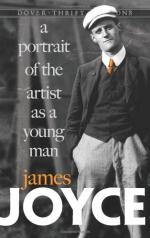—Why not, indeed? said Lynch, laughing.
—If A man hacking in
fury at A block of wood, Stephen
continued, make
there an image of A cow,
is that image A work of art?
If not, why not?
—That’s a lovely one, said Lynch, laughing again. That has the true scholastic stink.
—Lessing, said Stephen, should not have taken a group of statues to write of. The art, being inferior, does not present the forms I spoke of distinguished clearly one from another. Even in literature, the highest and most spiritual art, the forms are often confused. The lyrical form is in fact the simplest verbal vesture of an instant of emotion, a rhythmical cry such as ages ago cheered on the man who pulled at the oar or dragged stones up a slope. He who utters it is more conscious of the instant of emotion than of himself as feeling emotion. The simplest epical form is seen emerging out of lyrical literature when the artist prolongs and broods upon himself as the centre of an epical event and this form progresses till the centre of emotional gravity is equidistant from the artist himself and from others. The narrative is no longer purely personal. The personality of the artist passes into the narration itself, flowing round and round the persons and the action like a vital sea. This progress you will see easily in that old English ballad Turpin Hero which begins in the first person and ends in the third person. The dramatic form is reached when the vitality which has flowed and eddied round each person fills every person with such vital force that he or she assumes a proper and intangible esthetic life. The personality of the artist, at first a cry or a cadence or a mood and then a fluid and lambent narrative, finally refines itself out of existence, impersonalizes itself, so to speak. The esthetic image in the dramatic form is life purified in and reprojected from the human imagination. The mystery of esthetic, like that of material creation, is accomplished. The artist, like the God of creation, remains within or behind or beyond or above his handiwork, invisible, refined out of existence, indifferent, paring his fingernails.
—Trying to refine them also out of existence, said Lynch.
A fine rain began to fall from the high veiled sky and they turned into the duke’s lawn to reach the national library before the shower came.
—What do you mean, Lynch asked surlily, by prating about beauty and the imagination in this miserable Godforsaken island? No wonder the artist retired within or behind his handiwork after having perpetrated this country.
The rain fell faster. When they passed through the passage beside Kildare house they found many students sheltering under the arcade of the library. Cranly, leaning against a pillar, was picking his teeth with a sharpened match, listening to some companions. Some girls stood near the entrance door. Lynch whispered to Stephen:




